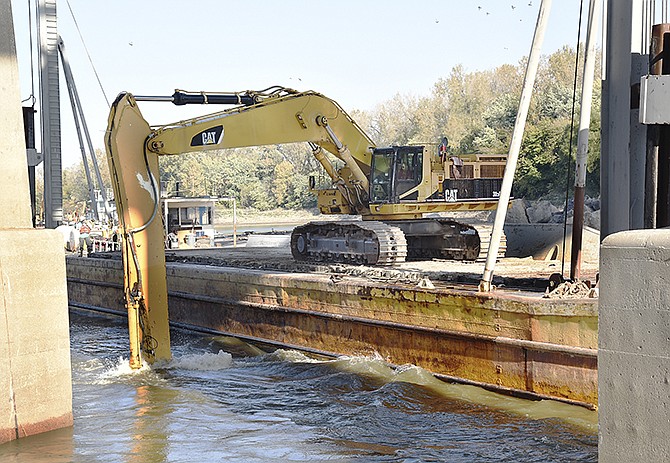In a river, "scour" is where the water flow washes away dirt and rocks from the river bank or from around the piers supporting a bridge.
Missouri's Transportation Department is spending about $1.5 million to repair some scour issues around the middle-of-the-river piers supporting the two U.S. 54/63 bridges over the Missouri River in Jefferson City.
"There is no danger" to the bridge structures or the traveling public's safety, Patty Lemongelli, MoDOT's Central District construction and materials engineer, told reporters Wednesday. "This is just maintenance work.
"If we were to ignore it, over time it probably would become a problem."
Chuck Sullivan, a MoDOT Central District resident engineer, noted, "What this will do is, it will keep everything from eating into those edges around the bridge, so it doesn't scour out and undermine the bridges."
The work involves placing two layers of large, 6-feet by 12-feet filter bags - 345 bags total, filled with chat rock and weighing about 7,500 to 8,000 pounds each - around the bases of both piers, then covering those bags with large rocks.
The rocks vary from two- to five-feet tall, and from 1,000 to 10,000 pounds each.
Excavation equipment loaded onto one barge first lifted the sandbags from other barges and placed them in the river around the piers.
That equipment is scooping up the rocks and placing them into the river in a planned pattern. The rocks are piled higher closer to the piers and slope away from the piers into the river channel, Lemongelli said.
"They went down about 30 feet or so," she said, "and by the time they get done - with the water level it's currently at - the rock is probably about 15 feet below the water."
There's no danger to shipping or other river traffic.
"The Coast Guard had to review the plans," Lemongelli said. "Everybody was good with how the project was set up."
Luhr Bros. Inc. of Columbia, Illinois, began the work Oct. 12 and likely will be done by the end of next week - ahead of the planned mid-November completion date.
The Jefferson City project is using about a dozen barge-loads of rock. Another three barges were needed to bring the "sandbags" to the work site.
"Each barge carries around 1,400 to 1,500 tons," said Robert Flannery, a Luhr Bros. riverboat pilot.
The material is shipped from the Tower Rock Stone Co. quarry at Ste. Genevieve in six-barge tows, Flannery said, and "each shipment takes about four days" to reach Jefferson City.
Projects like this are done on an as-needed basis, and the Jefferson City work isn't the first time MoDOT has stabilized bridge piers in this manner.
"We've done much smaller ones," state Bridge Engineer Dennis Heckman said. "Also, I believe the Boone Bridge project in Chesterfield has this type of work under contract."
Sullivan said MoDOT inspects all bridges on a regular basis.
"If something is scouring really badly, then they will repair it," he said. "When we looked at this (in Jefferson City) in 2013, it was a really bad hole."
Although MoDOT uses divers to check bridge supports in many rivers and creeks around the state, sonar equipment is needed to check the condition of Missouri River structures because the river is so muddy.
Sonar also is being used to monitor the progress of the maintenance work.
The project has no impact on the bridge traffic crossing the river above the work site, and most travelers won't be aware the work is being done.
"It's not the most glamorous work. It doesn't put more pavement or more miles of (road) out there," Lemongelli said. "However, when you think how important this structure is to commuters and to the traveling public, we need to take care of it and we need to maintain it.
"We do some pretty fascinating stuff that, maybe, a lot of people don't realize, in order to provide them with a safe and viable transportation system."

